IDEX Online Research: Diamond Prices Fall In November, Yet Above Last Year’s Levels
December 04, 08
Confusion reigns over polished diamond prices. Diamantaires claim they don’t know the “real” prices for diamonds, especially during this period of economic turmoil. In fact, the “real” answer is here: the IDEX Online Polished Diamond Price Report.
The IDEX Online Polished Diamond Price Report updates the average asking price for diamonds about twenty times a day. The IDEX Online Polished Diamond Price Report has no opinions, no interpolated numbers, no sample of selected dealers’ prices, no theory. It is simple: the IDEX Online Polished Price Report has only the facts.
Here are the facts for November 2008:
- Polished diamond prices fell by nearly 5 percent in November versus October 2008.
- Polished diamond prices are still nearly 7 percent higher in November 2008 versus the same month a year ago – November 2007.
- Diamond prices declined at a steady, orderly rate during November, reflecting slackening market demand. There was no panic selling during the month.
Here are the IDEX Online month-end asking prices for the major diamond categories:
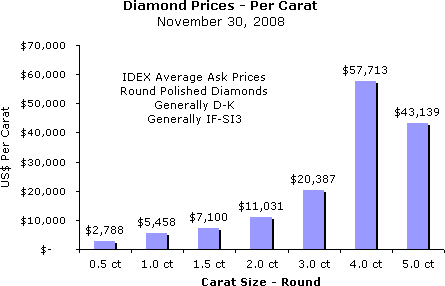
Source: IDEX Online
If these are the average “asking” prices for polished diamonds, what were the “real” prices of actual diamond trades?
In general, “real” transaction prices in November were about 10-12 percent lower than the asking price as shown on the IDEX Online Polished Price Report.
Polished Diamond Prices Down about 5% in November vs October
As expected, polished diamond prices softened in November. The IDEX Online Polished Price Index registered 122.03 for the month, based on average prices during the 30-day period. This compares to 128.09 for October and 114.15 for November 2007. Here’s what these indices mean:
- Polished diamond prices declined by about 5 percent during November versus October 2008, based on average prices during the month. Prices weakened steadily throughout the month. When prices of polished diamonds at the end of the month (November) are compared to diamond prices at the end of October, prices also declined by about 5 percent.
- Polished diamond prices in November averaged about 7 percent higher than diamond prices a year ago in November 2007. In other words, despite economic turmoil, polished diamond prices remain above last year’s levels.
- If diamond prices follow the historical trend line, they will need to fall another 4-5 percent, before reaching the historical average trend line. However, the reality is that diamond prices are likely to fall further, before recovering to their historical trend line later in 2009.
The graph below summarizes the IDEX Online Polished Diamond Price Index for the past 24 months. This graph represents the composite average asking prices of all diamonds traded at the wholesale level. The slope of the line steepened in the first half of the year, reflecting consistently higher prices – and a greater rate of price inflation – for virtually all diamond sizes. However, since June, polished diamond price inflation has paused – and plunged – as the red line illustrates.
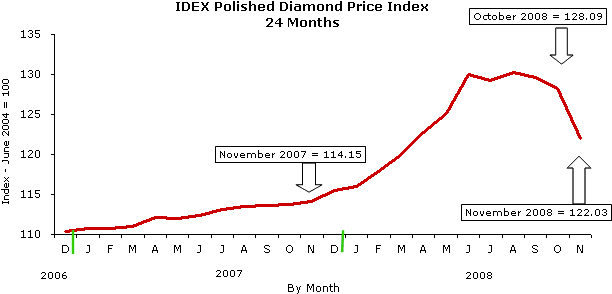
Source: IDEX Online Research
Prices Falling Faster for Large Stones
The graph above summarizes price trends for the aggregate market. However, not all polished diamond prices are falling at the same rate.
In the current environment, prices for stones larger than 2.0 carats are slipping more rapidly than prices for smaller polished diamonds.
The graph below summarizes the long term price trends for the past two years for the seven key diamond sizes, based on the IDEX Online Polished Diamond Price Index.
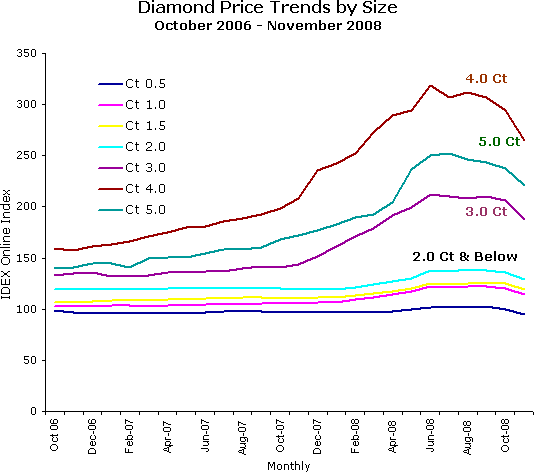
Source: IDEX Online
 |
November 2008 versus October 2008: (4.8 percent)
That is an unrealistic deflation rate. But the current pause in inflationary trends is welcome throughout the polished diamond distribution pipeline, since margins were being squeezed at all levels beyond the mining segment. The IDEX Online Polished Diamond Price Index, calculated on the average daily prices, stood at 122.03 for the month, modestly down from 128.16in October. At the end of November, the Index had slipped to 119.44, reflecting a steady decline during the month. The IDEX Online Polished Diamond Price Index stood at 100.00 in July 2004.
The graph below summarizes month-to-month changes in global diamond prices for the past thirteen months. Beginning in February 2008, polished diamond prices showed large gains during every month in the first half of the year.
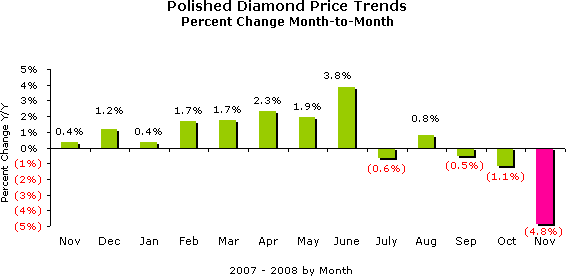 Source: IDEX Online |
November 2008 versus November 2007: +6.9% 
We think that polished diamond prices are likely to continue to decline, and will dip below the historical trend line inflation rate of 3-4 percent annually.
Even though November’s year-over-year inflation rate moderated, it is unreasonable to believe that this annualized level of diamond price inflation – nearly +7 percent – is sustainable, even though rough diamond prices have risen by about 16 percent or so this year. However, most other commodities have risen sharply in price over the past several years, followed by a volatile decline in the past couple of months. As we have said many times, the polished diamond industry remains too fragmented for anyone – or any group – to hold pricing power similar to the tight-knit community of rough diamond suppliers.
The graph below summarizes the year-over-year inflation rate by month for polished diamond prices in the global market for the past thirteen months.
Comparisons are based on the daily average prices during the month versus the same month a year ago. The year-to-year comparison takes into account the seasonality of polished diamond demand and prices.
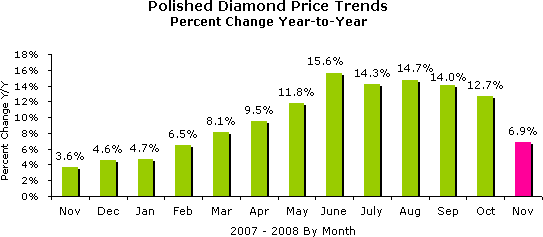
Source: IDEX Online
Daily Polished Prices Drifted Steadily Lower During the Month
Polished diamond prices drifted steadily lower in November; there were no notable price spikes up or down during the month. The price decline was orderly. After accelerating for the first half of 2008, polished diamond prices stabilized in June, and have decelerated since then. This coincides with the slide of global financial markets as investors and merchants became more worried about the likelihood of a worldwide recession. Diamond traders found that they were unable to buy and sell diamonds at the artificially high prices reflected on some industry price lists; thus, overall asking prices declined slightly to more realistic levels. Still, there was no panic similar to that which characterized the global financial markets.
The following graph illustrates the average price of polished diamonds on a day-by-day basis for the three-month period September-November 2008.
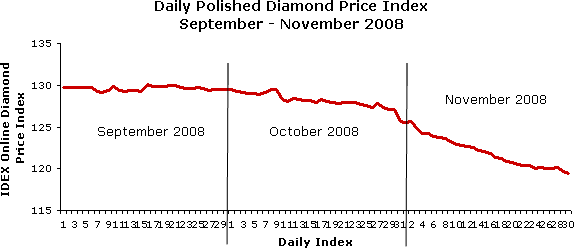
Source: IDEX Online
While the graph above represents an index of polished diamond prices, it is more instructive for diamantaires to understand how much – in U.S. dollars – polished diamond prices declined during the month.
The graph below compares diamond prices for selected key diamond categories. The price comparisons are based on end-of-month prices – October 31, 2008 versus November 30, 2008.
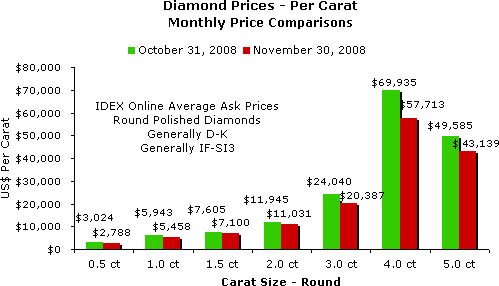
Source: IDEX Online
Month-to-Month Diamond Prices Decline for Most Sizes
After stabilizing for several months, month-to-month polished diamond prices have shown some decline for almost all of the key sizes. While demand had been strong for large diamonds – in the 4-5 carat range – retailers are now seeing some shopper reticence as consumers buy “down.” Rather than buying the largest, fanciest stone, shoppers are willing to compromise on either quality or size. Shoppers are opting for more modest, though flashy stones, according to retail merchants’ reports. Thus, prices for these larger stones have shown a greater decline than some of the other key sizes over the past month. These trends support the old adage: the faster prices rise, the harder they fall on the way back down.
The graph below summarizes the price changes for key sizes of polished diamonds on a month-over-month basis: November versus October. These seven stone sizes represent about 33 percent of the trading market by value.
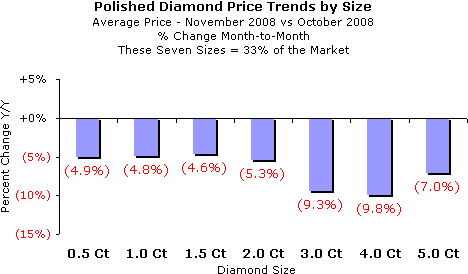
Source: IDEX Online
Year-Over-Year Diamond Prices for All Sizes Show Decelerating Inflation
On a year-to-year comparison, polished diamond prices rose at a double-digit rate only for three-carat and larger stones. In part, this is an anomaly of the math, because the fact is this: prices for larger stones are declining. However, as has been the trend for this diamond demand cycle (about 3-4 years), prices for large stones in the three-to-five carat range have shown a higher inflation rate than prices for stones two-carat and smaller stones. It is important to note that the year-over-year price inflation rate for polished diamonds is decelerating.
The graph below summarizes polished diamond prices by key sizes on a year-over-year basis: November 2008 versus November 2007. These seven sizes represent about one-third of the market, by aggregate value.
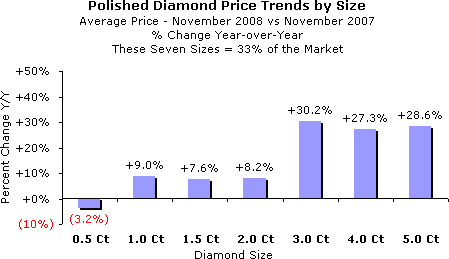
Source: IDEX Online
Forecast: Polished Diamond Prices Likely to Decline Near Term
The inflation flames related to polished diamond prices have been snuffed out. Prices rose at unrealistic rates in the first half of the year; we do not foresee this trend in the second half of 2008. There is too much uncertainty related to the global economic situation to fuel continued diamond price inflation at the unusually high rates earlier this year.
After a strong first half, economic growth in the U.S. as measured by Gross Domestic Product (GDP) finally slid into slightly negative territory – 0.3 percent down – in the third quarter. The National Bureau of Economic Research, the body that determines when the U.S. is in a recession, has declared that the economy has been in a recession since December 2007. Most economists are predicting another quarter, at least, of modestly negative economic growth.
In an effort to keep the world’s economies from slipping further into recessionary territory, central banks worldwide are pumping money into their economies. This should help credit market liquidity and stimulate growth. The U.S. government has been the leader in attempting to blunt the impact of a recession, and it appears to have had a somewhat stabilizing impact on the economy.
Unfortunately, consumers have been particularly hard-hit. Both real estate and stock prices are down; these two categories are typically shoppers’ largest asset categories. When consumers feel less wealthy, they tend to tighten their purse strings.
Oil prices have retreated, so consumers’ pocketbooks won’t be as pinched, as we head into the holiday selling season. This could help maintain demand for discretionary goods such as jewelry.
Our forecast calls for diamond prices to drop another 4-5 percent in December, until they hit the long term trend line for price inflation – about +3-4 percent annually. However, it is highly likely that polished diamond prices will drop further in subsequent months, until consumer demand stabilizes.
If the diamond markets operate on the basis of capitalism, then demand and supply should help stabilize diamond prices as they retreat toward their historic inflation rate. Unfortunately, life doesn’t work that way. Diamonds could drop to unrealistically low prices before stabilizing and recovering sometime in 2009. While capitalism – and its inherent supply and demand – isn’t perfect, no one has come up with a better, more successful long term alternative.
The IDEX Online Diamond Price Index
The IDEX Online Diamond Price Index is a real-time index derived from actual asking prices in the global diamond industry. The IDEX Online Diamond Price Index objectively reflects price trends as they happen. The Diamond Index and Diamond Drivers were formulated following comprehensive research and analysis of the IDEX Online inventory database, aggregated since 2001. Research and development were conducted in cooperation with Dr. Avi Wohl, Senior Lecturer of Finance at the faculty of Management, Tel Aviv University, Israel.
Additional information is available from IDEX Online Research. The e-mail address is diamondprices [at] idexonline [dot] com.